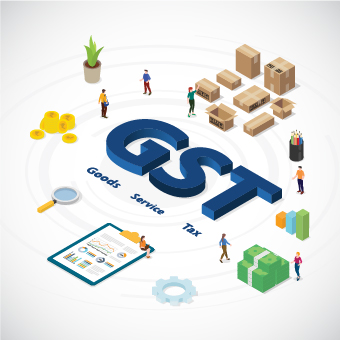To know more about these four types, keep reading this article.
1) IGST – Integrated Goods and Services Tax
Applicable on interstate supply of goods and/or services alongside imports and exports, the Integrated Goods and Services Tax falls under the IGST Act. This tax is collected by the Central Government, after which it is divided across respective states. For example, if a customer from Maharashtra purchases goods from a trader in Karnataka, then IGST is applicable on the transaction. The tax is then collected by the Central Government.
2) SGST – State Goods and Services Tax
While the IGST is applicable on interstate transactions, the SGST or the State Goods and Services Tax is imposed on intrastate transactions. This tax is imposed along with the CGST. The SGST is governed by the SGST Act. If the customer and the trader are from the same state, then the tax is equally divided between CGST and SGST. The SGST is then claimed by the government of the respective state.
3) CGST – Central Goods and Services Tax
The Central Goods and Services Tax or the CGST is applied on intrastate supply of Goods and Services. The CGST falls under the CGST Act and is collected by the Central Government. As mentioned earlier, the CGST is usually levied alongside the SGST on intrastate transactions (Transactions within the same state). While the SGST is claimed by the state government, the CGST is as mentioned, collected by the state.
4) UTGST – Union Territory Goods and Services Tax
The UTGST or the Union Territory Goods and Services Tax is like the State Goods and Services Tax, but is levied upon the supply of Goods and services in the Indian Union Territories (UTs). This includes Daman Diu, Dadra and Nagar Haveli, Lakshadweep, Chandigarh and Andaman and Nicobar Islands. It is governed by the UTGST Act and the revenue collected from it is claimed by the Union Territory Government. One can understand it as a counterpart of the SGST in Union Territories, and hence the UTGST is levied alongside the CGST.
After the introduction of How to get GST registration, there are multiple benefits that taxpayers and businesses avail.
1) Uniformity in Tax
Through the GST, India has become an integrated economy with a common thread of taxes in its supply into the national market. This uniformity also extends to imported goods with the help of the IGST and hence it brings together the local, as well as imported goods.
2) Common Portal
Now taxpayers have a common portal that oversees different processes such as tax payments, refunds, returns, registration, etc. Through this, you can expect quick services since the portal would provide direct access to various services related to GST.
3) Regulation for all industries
GST ensures that the various unorganised and unregulated industries of the country are regulated by aiming to ensure that compliances and payments are processed online.
4) Compliances – Simpler and lesser
Due to the tax rates, laws and procedures being in sync, the compliances are much simpler, and the tax is allocated uniformly between states and also between the state and the centre.
5) Cascading Taxes!
The GST prevents the cascading taxes by being an all-inclusive tax credit system. It has streamlined the tax system at its various levels through seamless accessibility
With its array of types and benefits, the GST has set benchmarks in the list of tax reforms especially by being a seamless system of unification of the country’s tax system inter, as well as intrastate. By providing a simplified tax structure, the GST registration process can now be understood by the masses of the country. When the country knows its tax, it’s only good news for the economy!




